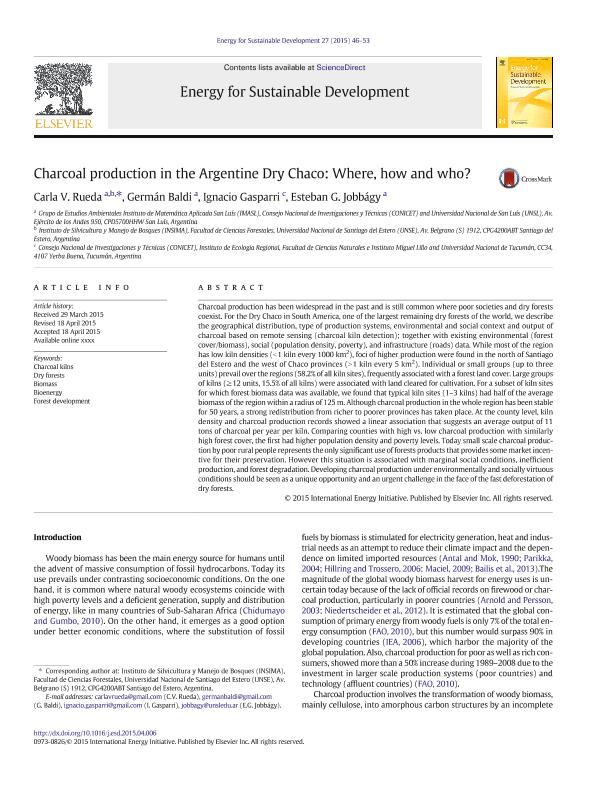Mostrar el registro sencillo del ítem
dc.contributor.author
Rueda, Carla Vanezza

dc.contributor.author
Baldi, Germán

dc.contributor.author
Gasparri, Nestor Ignacio

dc.contributor.author
Jobbagy Gampel, Esteban Gabriel

dc.date.available
2017-01-31T21:07:20Z
dc.date.issued
2015-08
dc.identifier.citation
Rueda, Carla Vanezza; Baldi, Germán; Gasparri, Nestor Ignacio; Jobbagy Gampel, Esteban Gabriel; Charcoal production in the Argentine Dry Chaco: Where, how and who?; Elsevier Inc; Energy for Sustainable Development; 27; 8-2015; 46-53
dc.identifier.issn
0973-0826
dc.identifier.uri
http://hdl.handle.net/11336/12281
dc.description.abstract
Charcoal production has been widespread in the past and is still common where poor societies and dry forests coexist. For the Dry Chaco in South America, one of the largest remaining dry forests of the world, we describe the geographical distribution, type of production systems, environmental and social context and output of charcoal based on remote sensing (charcoal kiln detection); together with existing environmental (forest cover/biomass), social (population density, poverty), and infrastructure (roads) data. While most of the region has low kiln densities (<1 kiln every 1000km2), foci of higher production were found in the north of Santiago del Estero and the west of Chaco provinces (>1 kiln every 5km2). Individual or small groups (up to three units) prevail over the regions (58.2% of all kiln sites), frequently associated with a forest land cover. Large groups of kilns (≥12 units, 15.5% of all kilns) were associated with land cleared for cultivation. For a subset of kiln sites for which forest biomass data was available, we found that typical kiln sites (1-3 kilns) had half of the average biomass of the region within a radius of 125m. Although charcoal production in the whole region has been stable for 50years, a strong redistribution from richer to poorer provinces has taken place. At the county level, kiln density and charcoal production records showed a linear association that suggests an average output of 11 tons of charcoal per year per kiln. Comparing counties with high vs. low charcoal production with similarly high forest cover, the first had higher population density and poverty levels. Today small scale charcoal production by poor rural people represents the only significant use of forests products that provides some market incentive for their preservation. However this situation is associated with marginal social conditions, inefficient production, and forest degradation. Developing charcoal production under environmentally and socially virtuous conditions should be seen as a unique opportunity and an urgent challenge in the face of the fast deforestation of dry forests.
dc.format
application/pdf
dc.language.iso
eng
dc.publisher
Elsevier Inc

dc.rights
info:eu-repo/semantics/openAccess
dc.rights.uri
https://creativecommons.org/licenses/by-nc-nd/2.5/ar/
dc.subject
BIOENERGY
dc.subject
BIOMASS
dc.subject
CHARCOAL KILNS
dc.subject
DRY FORESTS
dc.subject
FOREST DEVELOPMENT
dc.subject.classification
Ciencias Medioambientales

dc.subject.classification
Geografía Económica y Social

dc.subject.classification
CIENCIAS SOCIALES

dc.subject.classification
Silvicultura

dc.subject.classification
Agricultura, Silvicultura y Pesca

dc.subject.classification
CIENCIAS AGRÍCOLAS

dc.title
Charcoal production in the Argentine Dry Chaco: Where, how and who?
dc.type
info:eu-repo/semantics/article
dc.type
info:ar-repo/semantics/artículo
dc.type
info:eu-repo/semantics/publishedVersion
dc.date.updated
2017-01-31T18:29:54Z
dc.journal.volume
27
dc.journal.pagination
46-53
dc.journal.pais
Países Bajos

dc.journal.ciudad
Amsterdam
dc.description.fil
Fil: Rueda, Carla Vanezza. Consejo Nacional de Investigaciones Científicas y Técnicas. Centro Científico Tecnológico San Luis. Instituto de Matemática Aplicada de San Luis; Argentina. Universidad Nacional de San Luis; Argentina. Universidad Nacional de Santiago del Estero. Facultad de Cs.forestales. Instituto de Silvicultura y Manejo de Bosques; Argentina
dc.description.fil
Fil: Baldi, Germán. Consejo Nacional de Investigaciones Científicas y Técnicas. Centro Científico Tecnológico San Luis. Instituto de Matemática Aplicada de San Luis; Argentina. Universidad Nacional de San Luis; Argentina
dc.description.fil
Fil: Gasparri, Nestor Ignacio. Universidad Nacional de Tucumán. Facultad de Ciencias Naturales e Instituto Miguel Lillo. Instituto de Ecología Regional; Argentina. Consejo Nacional de Investigaciones Científicas y Técnicas; Argentina
dc.description.fil
Fil: Jobbagy Gampel, Esteban Gabriel. Consejo Nacional de Investigaciones Científicas y Técnicas. Centro Científico Tecnológico San Luis. Instituto de Matemática Aplicada de San Luis; Argentina. Universidad Nacional de San Luis; Argentina
dc.journal.title
Energy for Sustainable Development
dc.relation.alternativeid
info:eu-repo/semantics/altIdentifier/doi/http://dx.doi.org/10.1016/j.esd.2015.04.006
dc.relation.alternativeid
info:eu-repo/semantics/altIdentifier/url/http://www.sciencedirect.com/science/article/pii/S0973082615000344
Archivos asociados
